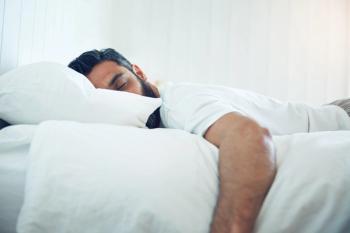
- Psychiatric Times Vol 15 No 3
- Volume 15
- Issue 3
Sleep Deprivation, Psychosis and Mental Efficiency
Today, average young adults report sleeping about seven to seven and one-half hours each night. Compare this to sleep patterns in 1910, before the electric lightbulb, the average person slept nine hours each night. This means that today's population sleeps one to two hours less than people did early in the century.
Today, average young adults report sleeping about seven to seven and one-half hours each night. Compare this to
Because of the advent of the lightbulb, people sleep 500 hours less each year than they used to. Unfortunately, our current "sleep diet" is significantly less than evolution intended. Most other primates (e.g., apes and monkeys) have a 24-hour sleep and activity cycle that is similar to that of humans who live in cultures where the siesta is still practiced. These animals have a long sleep at night, and a shorter sleep in the midafternoon, with a daily sleep total of about 10 hours. Humans seem to naturally need about the same amount of sleep. For instance, when the pressure of work, alarm clocks, social schedules and advanced technology is removed, people tend to sleep longer. Thus, in many less industrialized societies, the total daily sleep time is still around nine to 10 hours as it is for people when they are on unstructured holidays (Coren, 1996a).
Confirmation of these
Psychological researchers have tended to minimize the effects of sleep insufficiency, acknowledging that society may be getting too little sleep, but treating the effects of this sleep deprivation as nothing more significant than an inconvenience which makes people feel a bit tired now and then.
This view is incorrect. Recent research suggests that each day with insufficient sleep increases our sleep debt and, when this sleep debt becomes large enough, noticeable problems appear (Coren, 1996a). These sleep-debt-related problems are most predictable at certain times of the day. This is because the efficiency of our physical and mental functions show cyclic increases and decreases in the form of circadian rhythms. While our major sleep/wakefulness rhythm has a cycle length of roughly 24 hours, there are shorter cycles as well, with the most important of these being a secondary sleep/wakefulness cycle that is around 12 hours.
Because of these cycles, the pressure to fall asleep is greatest in the morning, between 1 and 4 a.m. In addition there is a less pronounced, but still noticeable, increase in sleepiness 12 hours later, between 1 and 4 p.m. It is this afternoon low point that makes you feel sleepy after lunch, not the meal that you may have just eaten. It probably also was the original reason for the afternoon nap or siesta.
People who are operating with a sleep debt are less efficient, and this inefficiency is most noticeable when the circadian cycle is at its lowest ebb. Among the common consequences of a large sleep debt are attentional lapses, reduced short-term memory capacity, impaired judgment and the occurrence of "microsleeps."
A microsleep is a short period of time, usually between 10 seconds to a minute in length, in which the brain actually enters a sleep state, regardless of what the person is doing at the time. The affected individual often does not know that this momentary blackout has occurred. The effects of these microsleeps combined with attentional lapses, however, can be dramatic.
There is now evidence that many major disasters have been due to sleep-debt related effects. The evidence shows that these include the oil spill of the Exxon Valdez, the nuclear accidents at Chernobyl and Three Mile Island, and the loss of the space shuttle Challenger (Coren, 1996a).
In fact, our societal sleep debt is so great that simply losing one additional hour of sleep due to the spring shift to daylight savings time can increase traffic accident rates by 7% (Coren, 1996b) and death rates due to all accidents by 6.5% (Coren, 1996c).
When sleep deprivation becomes great enough, the effects mimic those of psychosis. The failure of the scientific world to recognize this is due to some extent to the folklore that has grown up around the sleepless marathon of high school student Randy Gardner in 1964.
To gain an entry into the Guiness Book of World Records, he remained awake for 264 hours (11 days). Summaries of this case usually report that Gardner suffered no hallucinations, no paranoia or other negative mood changes, and that his mental, motor and sensory abilities were quite good throughout the entire episode. This conclusion is so widespread that it has now become a stock "fact" presented in virtually any psychology or psychiatry book that has a chapter on sleep.
This conclusion seems to be based on two items of information. The first was the observation that there were no obvious lasting physical or mental problems encountered by Gardner when he began to sleep again. The second was based upon observations of researcher William Dement (Dement, 1992), who interviewed Gardner on Day 10 of the experiment. He reported that he took Gardner to a restaurant and then played pinball with him, noting that Gardner played the game well and even won. Lt. Cmdr. John J. Ross of the U.S. Navy Medical Neuropsychiatric Research Unit in San Diego, who was called in by Gardner's worried parents to monitor his condition, tells a quite different story (Ross, 1965). Gardner's symptoms that Ross reported included:
- Day 2: Difficulty focusing eyes and signs of astereognosis (difficulty recognizing objects only by touch).
- Day 3: Moodiness, some signs of ataxia (inability to repeat simple tongue twisters).
- Day 4: Irritability and uncooperative attitude, memory lapses and difficulty concentrating. Gardner's first hallucination was that a street sign was a person, followed by a delusional episode in which he imagined that he was a famous black football player.
- Day 5: More hallucinations (e.g., seeing a path extending from the room in front of him down through a quiet forest). These were sometimes described as "hypnagogic reveries" since Gardner recognized, at least after a short while, that the visions were illusionary in nature.
- Day 6: Speech slowing and difficulty naming common objects.
- Day 7 and 8: Irritability, speech slurring and increased memory lapses.
- Day 9: Episodes of fragmented thinking; frequently beginning, but not finishing, his sentences.
- Day 10: Paranoia focused on a radio show host who Gardner felt was trying to make him appear foolish because he ws having difficulty remembering some details about his vigil.
- Day 11: Expressionless appearance, speech slurred and without intonation; had to be encouraged to talk to get him to respond at all. His attention span was very short and his mental abilities were diminished. In a serial sevens test, where the respondent starts with the number 100 and proceeds downward by subtracting seven each time, Gardner got back to 65 (only five subtractions) and then stopped. When asked why he had stopped he claimed that he couldn't remember what he was supposed to be doing.
In many respects Gardner's symptoms were similar to those experienced by a New York disk jockey, Peter Tripp, who endured a 200-hour sleepless marathon to raise money for the March of Dimes. During the course of his ordeal his thoughts became increasingly distorted and there were marked periods of irrationality. By the end of four days he could not successfully execute simple tests requiring focused attention. In addition, he began to have hallucinations and distorted visual perceptions. At one point Tripp became quite upset when he thought that the spots on a table were insects. He thought that there were spiders crawling around the booth and even once complained that they had spun cobwebs on his shoes.
He showed the same increasing moodiness and paranoia that Gardner did. On his last day, a neurologist was called to examine Tripp before sending him home. When Tripp looked up at this doctor in his dark, old-fashioned suit, he had the delusion that the doctor was really an undertaker who was about to bury him alive. Overtaken with fear, he let loose a scream and bolted for the door. Half-dressed, Tripp ran down the hall with doctors and psychologists in pursuit. He could no longer distinguish the difference between reality and nightmare.
This same pattern of mental deterioration that mimicks psychotic symptoms appears in several more systematic studies of sleep deprivation and extreme sleep debt. Thus, prolonged sleep deprivation does lead to the appearance of serious mental symptoms. In addition, even moderate amounts of sleep deprivation can lead to losses in mental efficiency that can threaten public and personal safety.
(According to a 1995 report by the U.S. Department of Transportation, 100,000 sleep-related traffic accidents claim some 1,500 American lives each year. The National Commission on Sleep Disorders Research has reported that sleep-related accidents, and sleep disorders which impact work productivity, cost the American economy between $100 and $150 billion each year-Ed.)
References:
References
Coren S (1996a), Sleep Thieves. New York: Free Press.
Coren S (1996b), Daylight savings time and traffic accidents. New Eng J Med 334:924.
Coren S (1996c), Accidental death and the shift to daylight savings time. Percept Mot Skills 83:921-922.
Dement WC (1992), The Sleepwatchers. Stanford, Calif.: Stanford Alumni Association.
Palinkas LA, Suedfeld P, Steel GD (1995), Psychological functioning among members of a small polar expedition. Avia Space Environ Med 66:943-950.
Ross JJ (1965), Neurological findings after prolonged sleep deprivation. Arch Neurol 12:399-403.
Webb WB, Agnew HW (1975), Are we chronically sleep deprived? Bull the Psychonomic Soc 6:47-48.
Articles in this issue
over 27 years ago
Psychiatry and Mental Illness: Are They Mass Media Targets?over 27 years ago
PTSD - Poemover 27 years ago
RUPPs Expand Knowledge of Pediatric Psychopharmacologyover 27 years ago
Atlanta's Strong STARTS Program Helps Educators Reach Troubled Kidsover 27 years ago
NIMH Cautiously Exploring Realm of Alternative Medicineover 27 years ago
Treating Adolescents by Debunking Family Mythsover 27 years ago
Preadoption Risk Factorsover 27 years ago
The NICHD Study of Early Child CareNewsletter
Receive trusted psychiatric news, expert analysis, and clinical insights — subscribe today to support your practice and your patients.












